NVIDIA Tegra X1 Preview & Architecture Analysis
by Joshua Ho & Ryan Smith on January 5, 2015 1:00 AM EST- Posted in
- SoCs
- Arm
- Project Denver
- Mobile
- 20nm
- GPUs
- Tablets
- NVIDIA
- Cortex A57
- Tegra X1
Automotive: DRIVE CX and DRIVE PX
While NVIDIA has been a GPU company throughout the entire history of the company, they will be the first to tell you that they know they can’t remain strictly a GPU company forever, and that they must diversify themselves if they are to survive over the long run. The result of this need has been a focus by NVIDIA over the last half-decade or so on offering a wider range of hardware and even software. Tegra SoCs in turn have been a big part of that plan so far, but NVIDIA of recent years has become increasingly discontent as a pure hardware provider, leading to the company branching out in unusual ways and not just focusing on selling hardware, but selling buyers on whole solutions or experiences. GRID, Gameworks, and NVIDIA’s Visual Computing Appliances have all be part of this branching out process.
Meanwhile with unabashed car enthusiast Jen-Hsun Huang at the helm of NVIDIA, it’s slightly less than coincidental that the company has also been branching out in to automotive technology as well. Though still an early field for NVIDIA, the company’s Tegra sales for automotive purposes have otherwise been a bright spot in the larger struggles Tegra has faced. And now amidst the backdrop of CES 2015 the company is taking their next step into automotive technology by expanding beyond just selling Tegras to automobile manufacturers, and into selling manufacturers complete automotive solutions. To this end, NVIDIA is announcing two new automotive platforms, NVIDIA DRIVE CX and DRIVE PX.
DRIVE CX is NVIDIA’s in-car computing platform, which is designed to power in-car entertainment, navigation, and instrument clusters. While it may seem a bit odd to use a mobile SoC for such an application, Tesla Motors has shown that this is more than viable.
With NVIDIA’s DRIVE CX, automotive OEMs have a Tegra X1 in a board that provides support for Bluetooth, modems, audio systems, cameras, and other interfaces needed to integrate such an SoC into a car. This makes it possible to drive up to 16.6MP of display resolution, which would be around two 4K displays or eight 1080p displays. However, each DRIVE CX module can only drive three displays. In press photos, it appears that this platform also has a fan which is likely necessary to enable Tegra X1 to run continuously at maximum performance without throttling.
NVIDIA showed off some examples of where DRIVE CX would improve over existing car computing systems in the form of advanced 3D rendering for navigation to better convey information, and 3D instrument clusters which are said to better match cars with premium design. Although the latter is a bit gimmicky, it does seem like DRIVE CX has a strong selling point in the form of providing an in-car computing platform with a large amount of compute while driving down the time and cost spent developing such a platform.
While DRIVE CX seems to be a logical application of a mobile SoC, DRIVE PX puts mobile SoCs in car autopilot applications. To do this, the DRIVE PX platform uses two Tegra X1 SoCs to support up to twelve cameras with aggregate bandwidth of 1300 megapixels per second. This means that it’s possible to have all twelve cameras capturing 1080p video at around 60 FPS or 720p video at 120 FPS. NVIDIA has also made most of the software stack needed for autopilot applications already, so there would be comparatively much less time and cost needed to implement features such as surround vision, auto-valet parking, and advanced driver assistance.
In the case of surround vision, DRIVE PX is said to deliver a better experience by improving stitching of video to reduce visual artifacts and compensate for varying lighting conditions.
The valet parking feature seems to build upon this surround vision system, as it uses cameras to build a 3D representation of the parking lot along with feature detection to drive through a garage looking for a valid parking spot (no handicap logo, parking lines present, etc) and then autonomously parks the car once a valid spot is found.
NVIDIA has also developed an auto-valet simulator system with five GTX 980 GPUs to make it possible for OEMs to rapidly develop self-parking algorithms.
The final feature of DRIVE PX, advanced driver assistance, is possibly the most computationally intensive out of all three of the previously discussed features. In order to deliver a truly useful driver assistance system, NVIDIA has leveraged neural network technologies which allow for object recognition with extremely high accuracy.
While we won’t dive into deep detail on how such neural networks work, in essence a neural network is composed of perceptrons, which are analogous to neurons. These perceptrons receive various inputs, then given certain stimulus levels for each input the perceptron returns a Boolean (true or false). By combining perceptrons to form a network, it becomes possible to teach a neural network to recognize objects in a useful manner. It’s also important to note that such neural networks are easily parallelized, which means that GPU performance can dramatically improve performance of such neural networks. For example, DRIVE PX would be able to detect if a traffic light is red, whether there is an ambulance with sirens on or off, whether a pedestrian is distracted or aware of traffic, and the content of various road signs. Such neural networks would also be able to detect such objects even if they are occluded by other objects, or if there are differing light conditions or viewpoints.
While honing such a system would take millions of test images to reach high accuracy levels, NVIDIA is leveraging Tesla in the cloud for training neural networks that are then loaded into DRIVE PX instead of local training. In addition, failed identifications are logged and uploaded to the cloud in order to further improve the neural network. Both of these updates can be done either over the air or at service time, which should mean that driver assistance will improve with time. It isn’t a far leap to see how such technology could also be leveraged in self-driving cars as well.
Overall, NVIDIA seems to be planning for the DRIVE platforms to be ready next quarter, and production systems to be ready for 2016. This should mean that it's possible for vehicles launching in 2016 to have some sort of DRIVE system present, although it's possible that it would take until 2017 to see this happen.



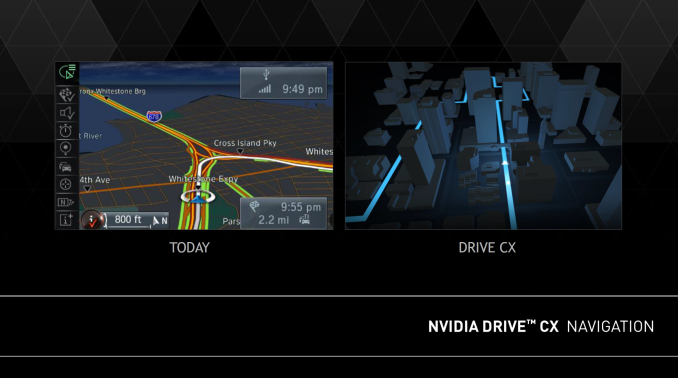
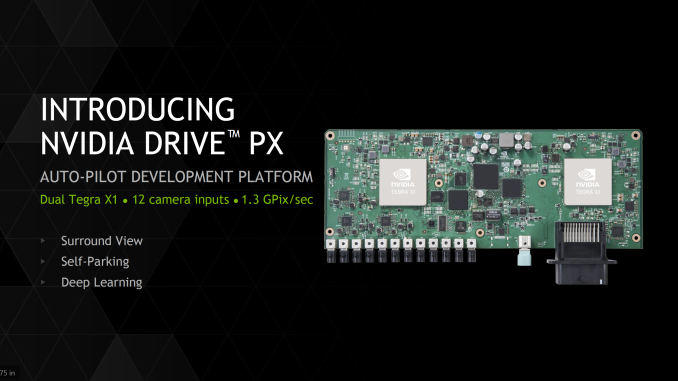
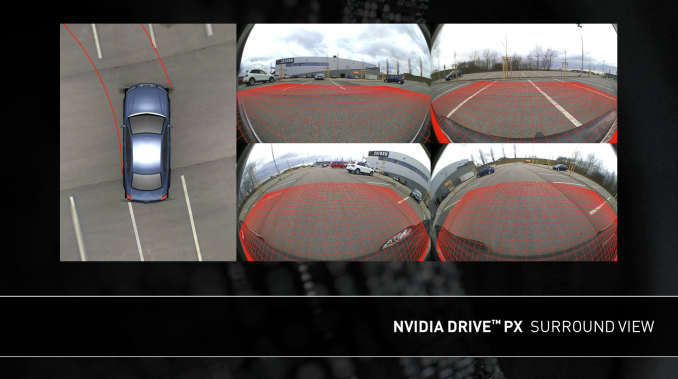

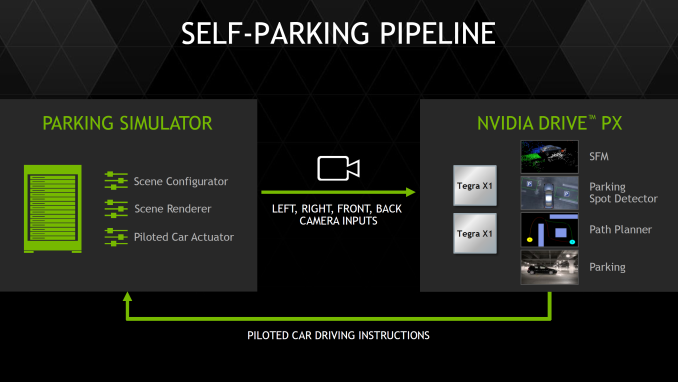


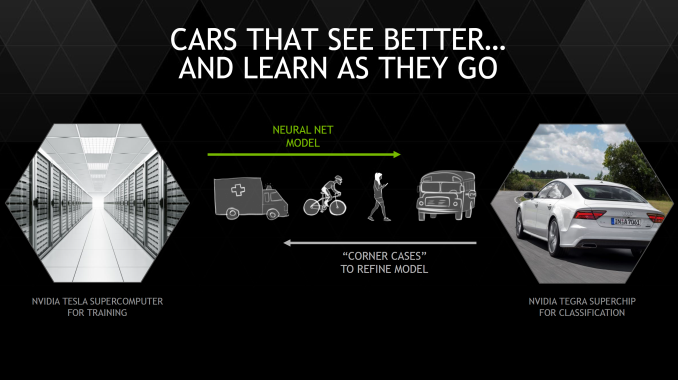
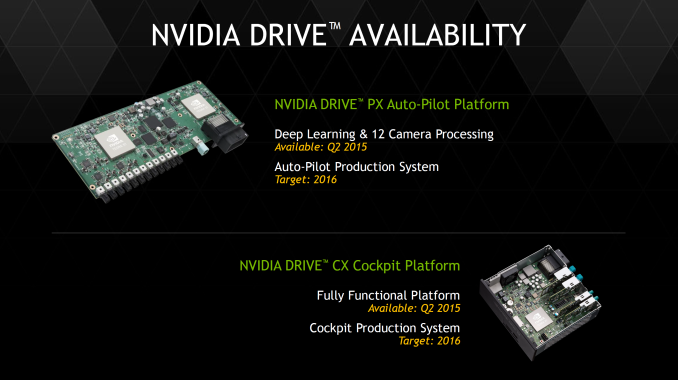








194 Comments
View All Comments
Maleficum - Tuesday, January 6, 2015 - link
In fact, Denver IS very special: it's NOT a custom ARM design, but an emulator, a reincarnation of Transmeta's Crusoe/Efficeon.The sad thing is however, that it has TONS of inherent issues, just like the Crusoe/Efficeon.
This time, nVidia did a wise choice by ditching this very questionable design and turned to the traditional native design.
Yojimbo - Tuesday, January 6, 2015 - link
They haven't ditched it. Per at least one top NVIDIA executive, Denver is expected to appear again in future products. Supposedly the reason why Denver is not appearing in the X1 is because it is not ready for the 20nm process shrink, and they want to bring the X1 out faster than Denver would allow. He said Denver is expected to be in 16nm products.chitownbarber - Tuesday, January 6, 2015 - link
Nvidia hired most of the Transmeta engineers, and have implemented at least one similar innovative feature from Transmeta into Denver called Dynamic Code Optimization which optimizes frequently used software routines.Jumangi - Monday, January 5, 2015 - link
Why are you saying "breaking into" an established market? Nvidia was in that market back with the Tegra 2 but their BS claims fell flat when put into real products and device makers abandoned them. They lost their market and now have to win it back again.chizow - Monday, January 5, 2015 - link
Really? What major design wins did the Tegra 2 have at the time? They have always been playing catch up with the likes of Qualcomm, Samsung, even TI back in that time period.At no time has Tegra ever been the market leader in mobile devices, so yeah, so much for that incorrect assertion, clearly they are trying to break into this market and looking at different ways of doing it.
Jumangi - Monday, January 5, 2015 - link
You must have a short memory. Tegra 2 was used in a number of phones because it was the first commercial quad core SoC and companies bought into Nvidia's claims. Then reality came and OEM's abandoned them and they have been trying to turn it around for years now.chizow - Tuesday, January 6, 2015 - link
Which phones? And still nothing even remotely close to the market share captured and retained by the likes of Qualcomm, even TI in that era.As for short memory, again, I believe you are mistaken, Tegra 2 was the first mobile "dual core", perhaps you were thinking of Tegra 3, which is probably still Nvidia's biggest commercial Tegra success but still nothing even remotely close to capturing the market lead as it was going up against the likes of Qualcomm's Snapdragon 400 series.
http://www.nvidia.com/object/tegra-superchip.html
chizow - Monday, January 5, 2015 - link
Also, perhaps the biggest boon of Nvidia's investment in mobile has been their amazing turnaround in terms of power efficiency, which is undoubtedly a result of their investment in mobile GPU designs and the emphasis on lowering TDP.techconc - Monday, January 5, 2015 - link
I would suggest that something like Pixelmator would be a good example of an app that leverages the power of the A8X. Though, I would agree that the A8X is overkill for most apps.DanD85 - Monday, January 5, 2015 - link
Seems to be that the Denver core will take the back seat this year. Judging from the performance of the nexus 9,Denver didn't really set the world on fire as Nvidia previously made it out to be. I think the K1 was relatively a let down last year with limited design win and spotty performance of the Denver architecture. I wonder when will Denver make a come back? 2016?